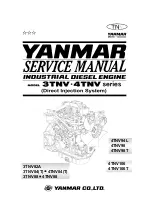
Installation, operation and maintenance instructions
High voltage flameproof motors for explosive atmosphere
AMD Rg 355-400-450-500
Aligning with driven equipment – Horizontal and vertical machines
Issued by: MOLM
Sheet No.
3AAM101032 E
Rev. B
Page. 1 of 3
01.2023
W
e
res
erv
e
a
ll
right
s
in
this
d
oc
u
ment
an
d
in
the
inf
or
mati
o
n
con
tai
n
e
d
th
er
e
in.
R
epr
od
uct
ion
,
use
o
f
disc
losur
e
to
t
h
ir
d
par
tie
s
w
itho
ut
ex
pr
es
s aut
h
or
ity
is
st
ric
tly
for
bidd
en.
INSTRUCTION FOR ALIGNING COUPLINGS
The aim of the instruction given in the following is to
attain proper alignment of the shaft extension without
angular or parallel mismatch. This requirement can be
fulfilled, as far as practically possible, by careful and
accurate workmanship. The alignment instructions
are basically valid for both rigid and flexible couplings
and for all kinds of driven equipment.
As well known, the linear dimension of the metallic
objects changes with the temperature. Therefore
during the alignment at ambient temperature, the
evaluation of the rotation centreline position at the
working temperature is suggested so it can be
decided how much radial displacement is to be set for
the cold machine in order to have the ideal condition
of zero misalignment at the expected operating
temperatures.
For steel structures, like the motor frame, the height
rise of the rotational centre of the shaft can be
calculated with the following formula
h
(mm)
10
-5
x H
(mm)
x
t
(°C)
where H = size of the motor (feet height)
t = difference between the alignment and the
working temperatures (about 30°C)
Remark: the formula is based upon the standard
thermal expansion of the steel, say about 0,01 mm for
meter and for centigrade degree of temperature
difference.
The same formula is applicable even for the driven
machine. The driven machine manufacturer must, in
any case, give the right calculated value.
The relevant measurements require that the machine
rotor can be turned.
If a horizontal machine with plain bearings has been
at standstill for a long period of time, then the oil film
between the bearings shells and the shaft will have
been pressed out by the weight of the rotor i.e. the
bearings will be dry.
Therefore, before turning the rotor, approximately
100 - 200 cm
3
of oil must be manually fed into each
bearing. This can be done through the openings in
the top of the bearing housing. The oil should be
poured in using a funnel. If the manufacturer has not
given details for setting radial displacement on the
cold machine, then the rule is that zero displacement
should be set.
ALIGNMENT
The following must be observed when coupling two or
more machines together.
The coupling halves must be exactly aligned to each
other, following the fundamental rule that the shaft
train is to be exactly horizontal (or vertical for vertical
machines). The shaft being coupled must naturally be
exactly concentric to each other and the coupling end
faces exactly parallel.
HORIZONTAL
MACHINES
WITH
SLEEVE
BEARINGS
Motors with sleeve bearings allow a certain axial float
of the shaft. It is very important to remember that the
motor cannot withstand any axial force from the
driving machine. All axial forces must be withstood by
the driven machine. Than the coupling must be of
limited axial float type in order to guarantee that the
sides of the bearings do not go in contact with the
shoulders of the shaft. The motors are designed for 6
mm of total axial float.
The coupling has to be made with the rotor standing
on its natural running centre. Consult the specific
technical documentation to obtain the exact value of
the distance between the coupling shoulder on the
shaft and the red mark on the external seals of the
DE side bearings. Axially move the motor until it is
assured that continuous free axial movement is
possible between the coupling halves to allow the
thermal expansion of the shaft (without damaging the
bearings) and the maintenance or the substitution of
the coupling.
INSTRUCTIONS FOR CHECKING ALIGNMENT
Each alignment check is to be preceded by a run-out
check on the coupling flanges.
HORIZONTAL MACHINES
Radial
misalignment
(Table 1)
and
angular
misalignment (Table 2) in the vertical plane can be
corrected on electrical machines by inserting shims
under the machine feet.
Refer also to the chapter “Machine foundations and
mountings”. Lateral radial misalignment (Table 1) and
lateral angular misalignment (Table 2) can be
corrected on electrical machines by moving the
machine in the lateral direction.
VERTICAL MACHINES
Radial misalignment (Table 1: vertical = lateral) can
be corrected on electrical machines by moving the
whole machines.
If the flanges are provided with spigots, then the
correction can be made on either of the two mating
flanges.
If flanges are not provided with spigots, correction can
be made by moving the whole machine radially within
the clearance allowed between the holes and the
fastening bolts in the coupling flanges.
Angular misalignment (Table 2: vertical = lateral) can
be corrected by inserting shims between the flanges
covering the greatest area of flange face as possible.
















































